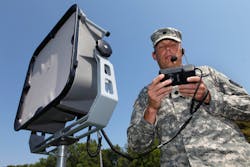QUANTICO, Virginia -- Police deployment of sonic blasters at Occupy Wall Street and G-20 protest rallies is fueling both sales and criticism of the devices, which emit beams of sound with laser-like intensity.
More U.S. police and emergency-response agencies are using the so-called Long-Range Acoustic Devices instead of megaphones or conventional loudspeakers for crowd control, according to news reports and leading manufacturer LRAD Corp. of San Diego.
But the products, which the makers developed as nonlethal options for military use, are prompting outcries from people on the receiving end, who call them "sound cannons." The city of Pittsburgh is fighting an American Civil Liberties Union lawsuit claiming the piercing tone from a police blaster during the 2009 G-20 summit permanently damaged a woman's hearing. At least one Occupy Wall Street protester says New York City police also used the punishing alert tone, although police say they have used the device only to broadcast messages.
LRAD says its products offer police something louder than a megaphone and more benign than rubber bullets and tear gas for managing crowds, defusing hostage situations and serving warrants on dangerous suspects.
"All of these events have helped bring interest to LRAD as new way to take care of these type of situations where they haven't had them before," company spokesman Robert Putnam said.
The publicly traded company had record sales of $26 million in the 2011 fiscal year ending Sept. 30, up 57 percent from a year earlier. Foreign and domestic military customers accounted for at least 58 percent of sales.
The company said Dec. 5 in its year-end report that it sees increased commercial applications for LRADs in areas including law enforcement.
The company developed the devices for the U.S. Navy after the deadly 2000 attack on the USS Cole off Yemen to give sailors a way of ordering small boats to stop approaching U.S. warships. Until 2009, they were known mainly for seagoing applications, including deterring pirates from attacking cruise ships. LRAD said the Louisiana National Guard used its products to communicate with victims of Hurricane Katrina in 2005.
The products range from a battery-operated, hand-held unit to a 320-pound (145-kilogram) device with an advertised range of nearly 2 miles (3.2 kilomaters). Even the smallest unit, the LRAD 100X, emits as much as 137 decibels at 1 meter. That's louder than a jet takeoff at 100 meters but lower than the pain threshold of 140 decibels, according to the U.S. Occupational Safety and Health Administration.
Putnam said LRAD broadcast levels are purposely kept below the threshold that could cause permanent hearing damage. He acknowledged that prolonged exposure can cause damage, comparing it to listening to fire siren for a long time.
The Associated Press witnessed a demonstration in September of the 149-decibel, 500X model at Marine Corps Base Quantico, in the northern Virginia suburbs of Washington. At a distance of about 250 yards (meters), it clearly emitted spoken words, a recorded train whistle and an annoying squeal — the alert tone.
Karen Piper, a University of Missouri professor, visited Pittsburgh during the September 2009 G-20 summit to research whether protesters have any effect on the International Monetary Fund and World Bank. She claims in a federal lawsuit she was about 100 feet (30 meters) from an LRAD mounted on a moving vehicle when it emitted a "piercing, continuous, high-pitched sound" for a number of minutes, causing permanent hearing loss.
The ACLU is representing Piper in her lawsuit against the city, alleging violations of her constitutional rights of assembly, privacy and due process. The complaint, filed in September, alleges the city was negligent, reckless and careless in its use of the LRAD.
The city denied Piper's claims recently in a court filing. It said its representatives used LRAD in accordance with the manufacturers' safety instructions.
The National Institute for Occupational Safety and Health says exposure to a sound of 120 decibels should not equal or exceed 9 seconds.
Raymond DeMichiei, deputy director of the Pittsburgh Office of Emergency Management and Homeland Security, said his agency supplied the LRADs to Pittsburgh police for the G-20 summit. He said he's never seen a better device for communicating with an unruly crowd.
"What would you rather have us do, the old 1964 routine with fire hoses and billy clubs? I think it's a lot more humane to make people uncomfortable because their ears hurt, and they leave," he said.
___
Associated Press writer Joe Mandak in Pittsburgh contributed to this report.
___
Online:
http://www.lradx.com




